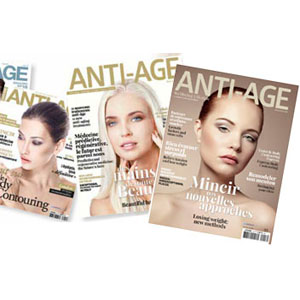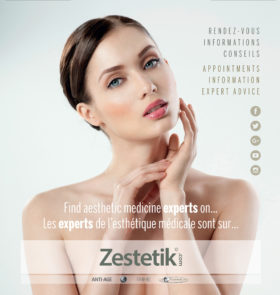by Sabine Zenker, Dermatologist, Munich, Germany
Racial and ethnic differences in facial shape, anatomical features and aesthetic conception are huge.
On an international scale, ethnic aesthetic trends have seen a big movement toward Western ideals. But these aesthetic trends do vary a lot and in all aspects. Looking at the anatomical aspects, especially key angles and proportions do vary in different ethnicities.
The presence of accentuated cheekbones is a beauty trait in many cultures as they form a symmetrical and lifted facial shape. But cheek`s shapes do vary: High cheekbones is a trait for people of Central- and Eastern Europe, Asian Women do show wider mandibles.
The evolving field of facial volume restoration is changing our concept of facial rejuvenation. As we are able to three-dimensionally re-store, re-define and re-shape facial structures and especially in a multi-layer way, one can realistically look for filling out sunken cheeks and for improvment the overall facial contour in a aesthetically very appealing way. After all and thanks to modern high-end techniques and filler material it has been shown clinically and in clinical research, that cheek augmentation improves feelings of facial attractiveness.
As facial aging does especially affect the midface, the attention drawn to this anatomical area and over the past years is important.
During the aging process, the negative gravitational effect can be understood as the action of negative vectors: As this is a three dimensional process, we refer to them as negative three dimensional vectors. To effect lift and shape, a corrective procedure using positive vectors that act in the opposite direction to the gravitational forces, i.e. laterally and cranially, can be effected with filler treatments “only”. This reduces the effect of the processes occurring as part of the aging process and restores the patient’s youthful facial proportions as far as possible. This procedure is known as a 3D vector technique.
The wish and desire to look and feel good is a common one. But every face is different and does require an individuall indication-specific treatment plan.
Ethnic Cheek Augmentation
Asian faces are generally wider than the ones of Caucasians. These differences are generalisation, though, as Asian faces tend to vary by ethnicity. In terms of anatomical features, Asian cheekbones tend to extend outward while Caucasian cheekbones protrude upward. So cheek`s prominence in Asians is higher, bone width larger and fat fullness more.
Besides these anatomical aspects, expectations and aesthetic perception do vary a lot inbetween different ethnicities: European women tend to expect to simply look better but not changed, many of them wouldn`t even tell their best friend that they had undergone any treatment. Russian women might tendentially look for accentuation of shape and form to expose their facial features in a more visible way. Asian women may not „need“ to improve cheek`s volume, they do rather look for more shape and lift as well as for camouflaging dimples and depressions.
Finally, the overall goal in treating cheeks is –and this is where all comes together- to subtly shape and lift those angles of the face and to add volume where it has been lost in a subtle, delicate, aesthetically appealing and individual way. The approach to achieve is new: filler treatments should be done nowadays and as said previously ethnicity-specific (different anatomical features require different techniques), indication-specific (not every filler with it`s properties matches the needs of different anatomical areas: e.g. for cheek treatment, highly viscous and highly elastic filler materials are advantageous as they lift precisely and therefore do have the potential to shape, too), smarter (using controlled, more precise ways of delivery such as with the aid of injection systems or less agressing injection tools such as blunt tip cannulas) etc..
Particular requirements have to be put on the materials used for these volume augmentation- and lifting procedures. There are different options in selecting biodegradable filler materials: One can choose in-between various Hyaluronic Acid Fillers and those based on Calcium Hydroxylapatite. The requirements to the filler material for those procedures are pretty the same: an ideal dermal filler material should be extremely viscous and elastic, such as is the case in the Calcium Hydroxylapatite-based dermal filler (CaHA, Radiesse®). This volume filler has both marketing authorisation from the American Drug Authority (FDA) and also CE certification. Compared with volumising products based on Hyaluronic Acid, Radiesse stands out because of its high level of viscosity and elasticity compared with the most common Hyaluronic Acid fillers. The absence of a hygroscopic effect is also a particular advantage. Overall, therefore, a very precise lifting effect is achieved by the injection of CaHA.
Techniques for Ethnic Cheek Augmentation
Basically, two important features for a youthful look one would look for in treating cheeks with fillers, are lateral accentuation, Ogee Curve, and Anterior Projection, “apple cheeks”. For Ethnic Cheek Augmentation, basically the same techniques can be chosen but they have to be adapted and customized individually.
Most commonly in Caucasian faces, a more accentuated Ogee Curve is desirable. To accentuate this lateral lift, the following technique is appropriate: The treatment starts with the first injection point on the cheek bone curve. The entry point may be given a local anaesthetic beforehand. Then a 1.5 inch long, blunt tip, flexible cannula is inserted in a medial ventral direction. It`s tip comes to rest on the supraperiosteal area. Now several linear threads of filler are placed in a fanningwise way supraperiostally. An even and sustained injection pressure is desirable. Correction should be done up to the clinical endpoint, overcorrection has to be avoided. A typical fan is done by appr. 0.1 ml of material, but, of course, the amount varies depending on the individual.
If anterior projection is desired -which is very suitable and pleasing to rejuvenate an Asian face- the following technique can be used: The entry point is set on the apex point of the cheek. To find this point, a perpendicular line is drawn from the orbital rim down. A second one coming from the chin, the corner of the mouth and finally this first line (modified Hinderer`s line). Whereever these two lines do cross, the apex point oft he cheek should be and will be after injection. (see pic 6). The injection itself should be performed by a sharp needle performig bolus-wise-injections supraperiostally on this point as well as banana-wise medially and laterally from this one in order to reach full correction up tot he clinical endpoint.
By applying those techniques, a most natural three-dimensional lifting and recontouring effect can be achieved.
At the end oft he day it is all about customising our treatments and about finding the appropriate one for each patient. As long as we try to handle the aesthetic concerns of our patients around the world accordingly, one does not have to feel shy about accepting a little help to turn back the clock!







